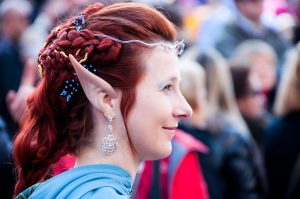
The base Elements of reality, or of mystical power, vary greatly between settings. In the real world their number is undefined (if we look at chemical elements they become increasingly shortlived as we go down the periodic table, with many being incapable of chemical interactions due to their tiny half-lives, while if we look at fundamental particles the list is incomplete and uncertain), but most settings that make use of them limit them rather more strictly – having them be well-understood phenomenon with a very definite list.
The Classical Elements
All can agree that Fire, Earth, Air and Water are classical elements, but there is commonly a fifth – Spirit, Void or Aether – representing things that are truly immaterial and cannot be felt in any way.
Looking at them in order of the complexity of assigning a colour to them:
Fire is always red.
Although the knowledge of white-hot flames is old, red fires were, and still are, by far the most common to encounter, with white flames requiring significant active effort to maintain in a forge or furnace.


